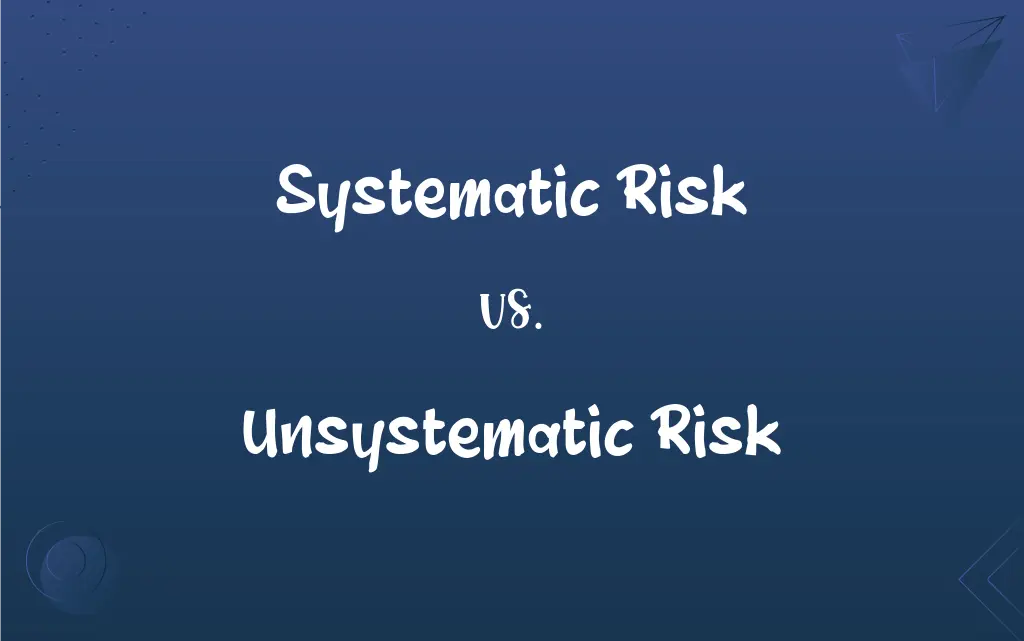Systematic Risk vs. Unsystematic Risk: What's the Difference?
Edited by Aimie Carlson || By Harlon Moss || Updated on October 12, 2023
Systematic risk affects the entire market and is non-diversifiable, while unsystematic risk is company-specific and can be reduced through diversification.

Key Differences
Systematic risk refers to the probability of a return that can be attributed to general economic factors, impacting the entire market. Events such as recessions, interest rate changes, or geopolitical crises exemplify systematic risk because they impact not just a single asset or a group of assets but the whole market. Conversely, unsystematic risk is inherent in a specific company or industry. It is the risk that arises from factors that are particular to a specific company, such as management performance, financial practices, or product performance.
One crucial distinction between systematic risk and unsystematic risk is how they interact with diversification strategies. While systematic risk is unavoidable and pervasive through the entire market, it cannot be mitigated through diversification. All investments, regardless of the sector, are subjected to systematic risk since it arises from macroeconomic factors. On the other hand, unsystematic risk, being specific to a particular company or industry, can indeed be mitigated, or even eliminated, through appropriate diversification strategies, like spreading investments across various sectors or geographic regions.
In the context of the Capital Asset Pricing Model (CAPM), systematic risk is relevant due to its unavoidable nature. Investors expect to be compensated for taking on systematic risk through higher expected returns. However, since unsystematic risk can be nearly or fully mitigated through diversification, the model doesn’t reward investors for taking on unsystematic risk. Therefore, the total expected return of an asset, according to CAPM, is determined only by its systematic risk.
The measurement of systematic risk often employs Beta (β), indicating how much a security or portfolio’s price moves relative to the market. A Beta value greater than 1 indicates the asset is more volatile than the market, while a Beta value less than 1 signifies less volatility. Unsystematic risk, however, doesn’t have a specific measurement metric due to its diverse nature and is often assessed through qualitative analysis, such as management evaluation and industry position, or through quantitative means like financial statement analysis.
Notably, while unsystematic risk can be strategically avoided, systematic risk represents an inherent aspect of investing in the market. An investor can minimize unsystematic risk by diversifying their portfolio, investing in a range of assets from various sectors and industries. Systematic risk, pervasive and inescapable, requires different mitigation approaches, such as hedging strategies or by seeking assets with negative correlation to the market.
ADVERTISEMENT
Comparison Chart
Source of Risk
Market-wide factors, like economic changes
Company or industry-specific factors
Diversification
Cannot be mitigated through diversification
Can be reduced/eliminated through diversification
Examples
Interest rate changes, inflation
Management changes, product failures
Measurement
Often measured using Beta (β)
Assessed through qualitative and quantitative analysis
Relation to Total Market
Correlated with overall market performance
Independent of overall market performance
ADVERTISEMENT
Systematic Risk and Unsystematic Risk Definitions
Systematic Risk
Systematic risk encompasses the unbridled vulnerabilities that affect a wide market or asset class.
Inflation spikes present a systematic risk as they can erode the real returns across numerous asset classes.
Unsystematic Risk
Unsystematic risk encompasses firm-related uncertainties, which can adversely affect its performance and stock value.
The release of a poorly received product can pose an unsystematic risk, diminishing a company’s profitability and stock price.
Systematic Risk
Systematic risk embodies the potential fluctuations in the market due to macroeconomic factors.
Global geopolitical unrest can instigate systematic risk by disrupting international trade and investment.
Unsystematic Risk
Unsystematic risk relates to the non-market risks that can influence a particular company’s value.
A lawsuit against a corporation illustrates unsystematic risk that may negatively impact its market position.
Systematic Risk
Systematic risk pertains to the overarching dangers stemming from economic shifts and broad market movements.
The systemic impact of changes in federal interest rates is a classic form of systematic risk affecting varied investments.
Unsystematic Risk
Unsystematic risk denotes the potential fluctuations in a company’s value due to internal or industry-specific variables.
A strike among a company’s workforce represents an unsystematic risk, which can hamper its production and earnings.
Systematic Risk
Systematic risk implies the pervasive, non-diversifiable hazard impacting all sectors of the market.
A widespread recession represents systematic risk by generally depressing asset values across the board.
Unsystematic Risk
Unsystematic risk involves the company-specific dangers that can impact its stock price.
A product recall due to safety issues exemplifies unsystematic risk adversely affecting the involved company's stock.
Systematic Risk
Systematic risk is the inherent peril associated with the entire market or market segment.
The 2008 financial crisis is a prime instance where systematic risk affected global markets.
Unsystematic Risk
Unsystematic risk is the unique vulnerabilities associated with an individual firm’s operations and business environment.
Sudden resignation of a company's CEO can trigger unsystematic risk, potentially disrupting its stock value.
FAQs
Is unsystematic risk relevant to specific industries or companies?
Yes, unsystematic risk is specific to particular companies or industries and can influence their performance.
What is an example of systematic risk?
An example of systematic risk is inflation, which can broadly impact the entire market.
How is systematic risk measured?
Systematic risk is often measured using Beta, indicating an investment's sensitivity to market movements.
Can systematic risk impact global markets?
Yes, systematic risk, such as global economic shifts, can influence markets worldwide.
Does unsystematic risk influence the overall market?
No, unsystematic risk generally affects only the specific company or industry involved, not the entire market.
What strategies can mitigate systematic risk?
Hedging strategies and investing in assets with negative correlation to the market can mitigate systematic risk.
How is unsystematic risk identified?
Unsystematic risk can be identified through analyzing company-specific factors, like management competence and financial stability.
What type of risk does diversification primarily minimize?
Diversification primarily minimizes unsystematic risk.
Is systematic risk affected by company management decisions?
No, systematic risk is independent of individual company management decisions and affects the entire market.
What is systematic risk?
Systematic risk refers to the market-wide risk affecting all investments and cannot be mitigated through diversification.
What characterizes unsystematic risk?
Unsystematic risk involves company-specific or industry-specific dangers that can be reduced through diversification.
Can systematic risk be diversified away?
No, systematic risk cannot be diversified away as it affects the entire market or segment.
How can unsystematic risk be minimized?
Unsystematic risk can be minimized through diversification, spreading investments across various assets, sectors, or industries.
What impacts systematic risk?
Macroeconomic factors, like changes in interest rates or geopolitical events, significantly impact systematic risk.
Do investors receive compensation for systematic risk?
Yes, investors expect to be compensated for systematic risk with higher potential returns.
What kind of events might trigger unsystematic risk?
Events like managerial changes, product failures, or industry disruptions might trigger unsystematic risk.
Can unsystematic risk affect stock prices?
Yes, unsystematic risk can significantly affect the stock prices of the specific companies involved.
Can investors avoid unsystematic risk entirely?
While difficult to avoid entirely, investors can significantly reduce unsystematic risk through adept diversification strategies.
Can you provide an example of unsystematic risk?
A company facing a product recall due to safety concerns is an example of unsystematic risk.
Is unsystematic risk associated with micro or macro-economic factors?
Unsystematic risk is associated with micro-economic factors, specific to individual companies or industries.
About Author
Written by
Harlon MossHarlon is a seasoned quality moderator and accomplished content writer for Difference Wiki. An alumnus of the prestigious University of California, he earned his degree in Computer Science. Leveraging his academic background, Harlon brings a meticulous and informed perspective to his work, ensuring content accuracy and excellence.
Edited by
Aimie CarlsonAimie Carlson, holding a master's degree in English literature, is a fervent English language enthusiast. She lends her writing talents to Difference Wiki, a prominent website that specializes in comparisons, offering readers insightful analyses that both captivate and inform.































































